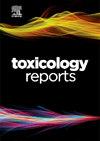Mini meta-analysis of anticholinesterase actions of atorvastatin, simvastatin and rosuvastatin, and in silico identification of their protein targets in Mus musculus
Q1 Environmental Science
引用次数: 0
Abstract
Dyslipidemic statins reduce blood and brain cholinesterase (ChE) activities in mice, with scarce information on other protein/enzyme targets. The study aims at conducting a mini meta-analysis on in vivo and in vitro adverse anti-ChE effects of atorvastatin, simvastatin and rosuvastatin in mice, and using the SwissPrediction to identify in silico body target proteins. The data comprised 72 records of plasma, erythrocytes and brain ChE activities, expressed as percent mean ± SD of respective controls. We conducted a randomized effects size single-arm meta-analysis. The risk of bias scoring was according to those of animal experiments. The effect size (% ChE activity) of statin treatments was significantly decreased by 25.85 % (combined effect size=74.15, p = 0.0001), with significant heterogeneity (Q=1133.19, p < 0.0001, I2=93.73 %). Subgroup analysis was significantly dose and concentration-dependent. The funnel plot showed non-symmetrical data distribution, with no imputed points. The risk of bias was moderate. In silico mouse body protein targets for the statins were mainly classes of Family AG protein- coupled receptor (20.0 %-33.3 %), Oxidoreductase (6.7–13.3 %) and Eraser (13.3 % each), with others at 0–26.7 %. The findings highlight statin effects in mice by reducing blood and brain ChE activities, in a dose/concentration-dependent manner, that would potentially modulate the cholinergic system. This anti-ChE effect together with in silico protein targets recognized could be the basis of further experimental explorations of adverse effects of statins.
阿托伐他汀、辛伐他汀和瑞舒伐他汀抗胆碱酯酶作用的小型荟萃分析,以及它们在小家鼠体内蛋白靶点的计算机鉴定
血脂异常的他汀类药物可降低小鼠血液和脑胆碱酯酶(ChE)的活性,但关于其他蛋白质/酶靶点的信息很少。本研究旨在对阿托伐他汀、辛伐他汀和瑞舒伐他汀在小鼠体内和体外的不良抗che作用进行小型荟萃分析,并使用SwissPrediction识别硅体靶蛋白。数据包括72条血浆、红细胞和脑ChE活性记录,以百分比平均值± SD表示。我们进行了随机效应大小的单臂meta分析。偏倚风险评分依据动物实验结果。他汀类药物治疗的效应量(% ChE活性)显著降低了25.85 %(综合效应量=74.15,p = 0.0001),异质性显著(Q=1133.19, p <; 0.0001,I2=93.73 %)。亚组分析呈显著剂量和浓度依赖性。漏斗图显示数据分布不对称,没有输入点。偏倚风险为中等。在硅小鼠体内,他汀类药物的蛋白靶点主要是AG家族蛋白偶联受体(20.0 %-33.3 %)、氧化还原酶(6.7-13.3 %)和橡皮擦(13.3 %),其他靶点在0-26.7 %。研究结果强调了他汀类药物对小鼠的影响,通过剂量/浓度依赖的方式降低血液和大脑ChE活性,这可能会调节胆碱能系统。这种抗che作用与已识别的硅蛋白靶点可作为进一步实验探索他汀类药物不良反应的基础。
本文章由计算机程序翻译,如有差异,请以英文原文为准。
求助全文
约1分钟内获得全文
求助全文
来源期刊

Toxicology Reports
Environmental Science-Health, Toxicology and Mutagenesis
CiteScore
7.60
自引率
0.00%
发文量
228
审稿时长
11 weeks
 求助内容:
求助内容: 应助结果提醒方式:
应助结果提醒方式:


